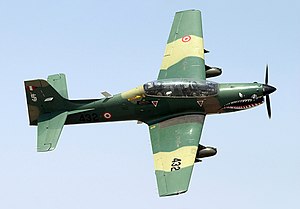
Back إمبراير إي إم بي 312 توكانو Arabic Embraer EMB 312 Tucano Czech Embraer EMB 312 German Embraer EMB-312 Tucano Spanish امبرائر ئیامبی ۳۱۲ توکانو Persian Embraer EMB 312 French Embraer EMB 312 Tucano Galician Embraer EMB 312 Tucano Croatian Embraer Tucano Hungarian Embraer EMB 312 Tucano Italian
| EMB 312 Tucano | |
|---|---|
 A Peruvian AT-27 | |
| General information | |
| Type | Trainer and light attack Aircraft |
| National origin | Brazil |
| Manufacturer | Embraer |
| Status | In Service |
| Primary users | Brazilian Air Force |
| Number built | 624[1] |
| History | |
| Manufactured | 1980–1996[2] |
| Introduction date | September 1983 |
| First flight | 16 August 1980 |
| Variants | Short Tucano |
| Developed into | Embraer EMB 314 Super Tucano |
The Embraer EMB 312 Tucano (English: Toucan) is a low-wing, tandem-seat, single-turboprop, basic trainer and counter-insurgency aircraft developed and produced by Embraer in Brazil. The Brazilian Air Force sponsored the EMB-312 project at the end of 1978. Design and development work began in 1979 on a low-cost, relatively simple, new basic trainer with innovative features which eventually became the international standard for basic training aircraft.[3] The prototype first flew in 1980, and initial production units were delivered in 1983.[3]
Production was initially supported by a local order for 118 aircraft, with options for an additional 50 units in October 1980. It was later matched by an Egyptian licence-produced purchase in 1993 and subsequently by a variant known as the Short Tucano, which was licence-produced in the United Kingdom.[4] The Tucano made inroads into the military trainer arena and became one of Embraer's first international marketing successes. A total of 664 units were produced (504 by Embraer and 160 by Short Brothers), flying in 16 air forces over five continents.[2]
- ^ ".::Portal Contato Radar – Portal de Aviação::". Archived from the original on 5 March 2016. Retrieved 12 August 2015.
- ^ a b Cite error: The named reference
contadorwas invoked but never defined (see the help page). - ^ a b "EMB 312 Tucano". Embraer Historical Center. Archived from the original on 23 July 2012. Retrieved 15 September 2012.
- ^ Todd, Daniel; Simpson, Jamie (30 March 1986). The World Aircraft Industry. Surry Hills, Australia: Croom Helm. p. 246. ISBN 0-7099-2486-0.